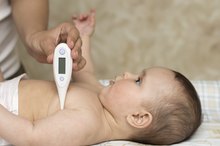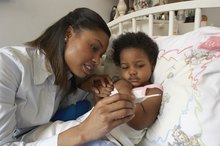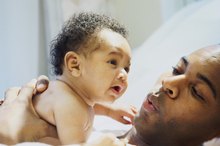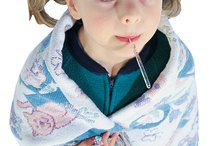Blotchy Skin Rash on a Baby's Face
When your baby suffers from a blotchy rash on his face, there could be several causes. Viruses, heat exposure and teething are all associated with red and splotchy rashes that appear on the face. Most rashes affecting babies disappear without any special treatment. If the baby is suffering from any discomfort because of the rash, your doctor may recommend a topical cream to relieve itching and dryness. Take your child to the pediatrician for a proper diagnosis.
Teething
A bright rash on the face could appear as a side effect of your baby’s teething. The face, lips, chin and neck area may be affected after the baby has excessively drooled while teething. The rash may appear raised in certain areas on the face. This type of rash lasts only temporarily and does not require treatment. If you are concerned about your baby’s comfort, apply a small amount of lanolin cream to the affected skin.
- A bright rash on the face could appear as a side effect of your baby’s teething.
- The rash may appear raised in certain areas on the face.
Heat Rash
Red Bumps on Babies' Skin
Learn More
Heat rash appears as clear or red spots on the surface of the baby’s skin. Any area of the body may be affected, including the face. Heat rash is a result of the baby's being exposed to high temperatures. Hot weather and overdressing the baby are common causes. Heat rash disappears typically when the baby is moved into cooler temperatures or extra layers of clothing are removed.
- Heat rash appears as clear or red spots on the surface of the baby’s skin.
- Heat rash is a result of the baby's being exposed to high temperatures.
Fifth Disease
When your baby has bright cheeks with a red blotchy appearance, she may be suffering from fifth disease, or parvovirus B19 infection 3. Other areas of the body where the rash could appear include the chest, hands and feet. Prior to the rash, your baby may have suffered a slight fever. Once the rash appears, it can last an average of seven to 10 days. The infection is viral and can be spread to other children and adults. No topical treatment is applied to the rash when the baby has been diagnosed with fifth disease 3.
Roseola
What Causes a Rash on a Baby's Face After Eating?
Learn More
The rash associated with roseola typically starts on the trunk and neck but can spread to a baby’s face and neck. The rash appears on spotty red bumps that are either flat or raised. Rosela is another viral illness and most commonly affects children between the age 6 months and 3 years. Additional symptoms of roseola include high fever, fatigue, eye swelling, appetite changes and diarrhea. The rash associated with roseola may last only a few hours to several days. No treatment is required for roseola.
- The rash associated with roseola typically starts on the trunk and neck but can spread to a baby’s face and neck.
Related Articles
References
- Ask Dr. Sears: Teething
- Babycenter: Roseola
- Babycenter: Fifth Disease
- Martin PE, Eckert JK, Koplin JJ, et al. Which infants with eczema are at risk of food allergy? Results from a population-based cohort. Clin Exp Allergy. 2015;45(1):255-64. doi:10.1111/cea.12406
- Waserman S. Doctor, can we prevent food allergy and eczema in our baby?. Curr Opin Allergy Clin Immunol. 2016;16(3):265-71. doi:10.1097/ACI.0000000000000267
- Wopereis H, Sim K, Shaw A, Warner JO, Knol J, Kroll JS. Intestinal microbiota in infants at high risk for allergy: Effects of prebiotics and role in eczema development. J Allergy Clin Immunol. 2018;141(4):1334-1342.e5. doi:10.1016/j.jaci.2017.05.054
Writer Bio
Heather Topham Wood is a seasoned writer whose work has appeared in numerous publications, including USA Today, Gadgetell, Feel Rich and Step in Style. Heather is a published novelist with six Amazon bestsellers and a contract through Crescent Moon Press. She holds a bachelor's degree in English from TCNJ.









